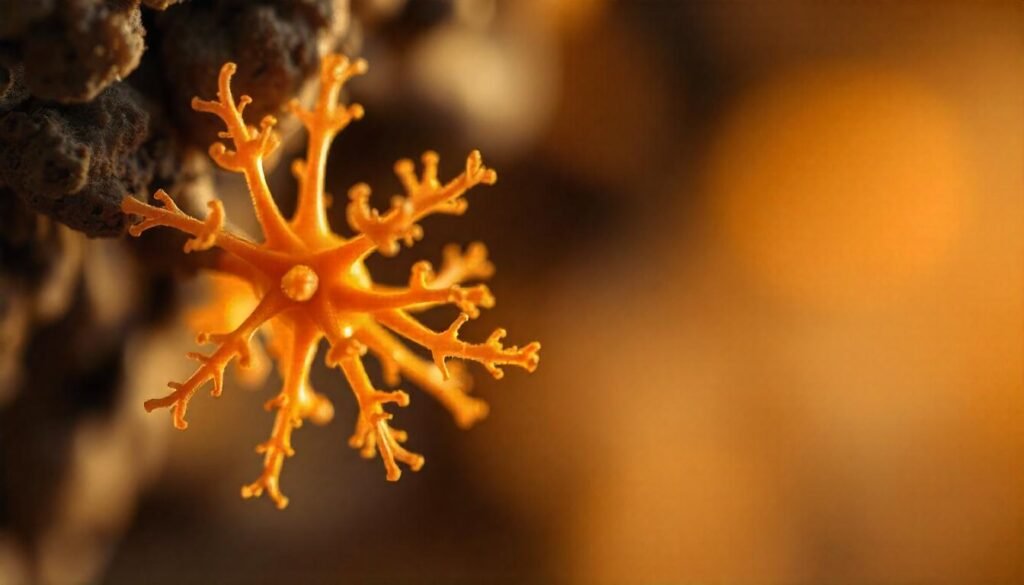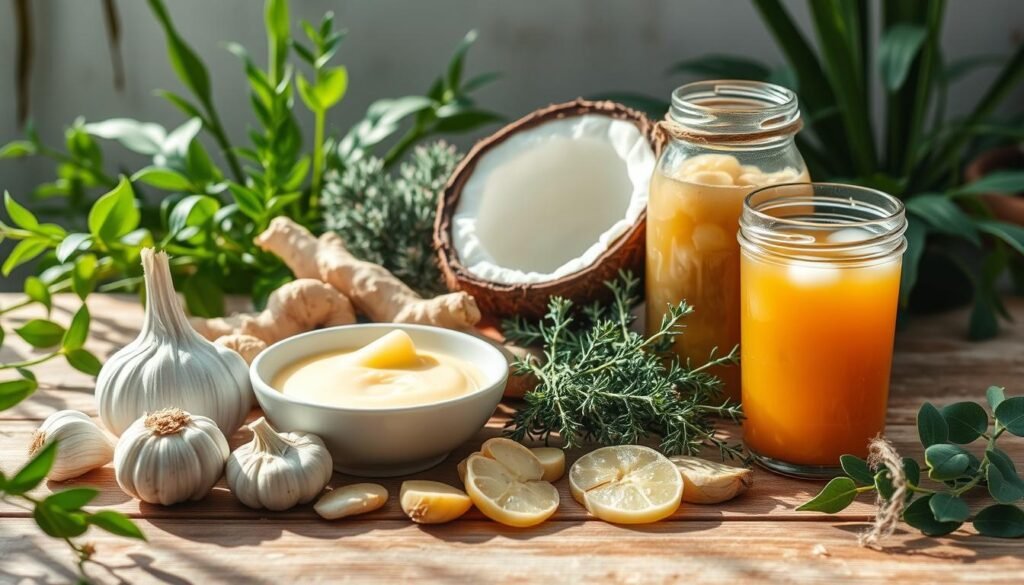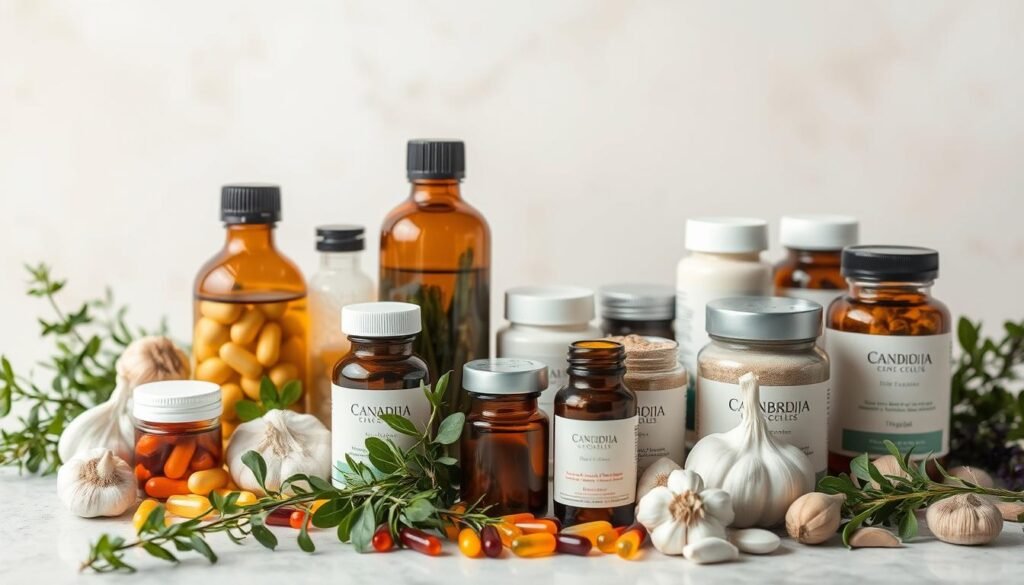Candidiasis is a common fungal infection caused by Candida species. It can really affect our health. But, there are candidiasis treatments, both natural and medical, that can help us fight it. In this guide, we’ll look at different ways to manage candidiasis. This will help you take control of your health and find the best solution for you.
Are you dealing with ongoing yeast infections or health problems? The answers might be in understanding and treating candidiasis. This article will explain Candida albicans, the main cause, and the treatments available. We’ll look at both medical and natural options to help you get your health back.

Table of Contents
Key Takeaways
- Candidiasis is a fungal infection caused by the Candida species, primarily Candida albicans.
- Both medical and natural treatment options are available to manage candidiasis effectively.
- Understanding the causes, risk factors, and symptoms of candidiasis is crucial for developing a comprehensive treatment plan.
- Dietary modifications, supplementation, and lifestyle changes can play a significant role in controlling Candida overgrowth.
- Seeking professional medical guidance is advisable for severe or recurring candidiasis cases.
Understanding Candidiasis: Causes and Symptoms
Candidiasis, also known as a yeast infection, is a common fungal infection. It’s caused by an overgrowth of the Candida albicans fungus. This fungus is naturally in our bodies but can grow too much under certain conditions. This can lead to uncomfortable and serious health problems.
It’s important to know the causes and early signs of candidiasis. This knowledge helps in finding the right candidiasis treatment and fungal infection therapy.
Common Risk Factors for Candida Overgrowth
- Antibiotic use that disrupts the gut microbiome
- Weakened immune system, such as from conditions like HIV or cancer treatments
- Diabetes, especially when blood sugar levels are poorly controlled
- Pregnancy and other hormonal imbalances
- Prolonged use of oral contraceptives
- Poor hygiene or excessive moisture in intimate areas
Identifying Different Types of Candida Infections
Candida albicans can cause different infections. These include Vaginal candidiasis yeast infections, oral thrush, skin infections, and invasive candidiasis. Each type needs a specific treatment plan.
Warning Signs and Symptoms to Watch For
The symptoms of candidiasis vary. But common signs include:
- Itching, burning, or irritation in affected areas
- Thick, white, or cottage cheese-like discharge
- Redness, rashes, or sores on the skin or mucous membranes
- Painful urination or intercourse
- Thrush (white patches in the mouth or throat)
- Fatigue, brain fog, and other systemic symptoms
Seeing these signs early and getting medical help quickly is key. It helps prevent the candidiasis treatment from getting worse or lasting longer.
The Science Behind Candida Albicans and Fungal Infections
Candida albicans is a yeast that causes candidiasis, a common fungal infection. It lives in the gut, mouth, and other moist areas. But, when the body’s balance is upset, Candida can grow too much and cause infection.
Understanding how Candida works with the body is key to managing it. It loves warm, moist places and can change to fit its environment. When the immune system is weak or the body’s pH is off, Candida can grow and spread, leading to symptoms.
| Factors Contributing to Candida Overgrowth | Potential Consequences of Candida Infections |
|---|---|
|
|
Learning about Candida and fungal infections is the first step to managing them. By knowing what triggers and symptoms to look for, people can take steps to balance their body. This helps prevent infections and improves health and well-being.
“The key to managing candidiasis is to address the underlying causes and support the body’s natural defenses against this opportunistic fungus.”
Medical Approaches to Candidiasis Treatment
Medical treatments are key in fighting candidiasis. Healthcare experts use oral and topical treatments to help patients. These methods aim to control the fungal infection and improve health.
Oral Antifungal Medications
Diflucan (fluconazole) is a common treatment for candidiasis. It stops the Candida fungus from growing. Patients might need to take these antifungal medications for weeks or months.
Topical Treatment Options
Healthcare providers also suggest topical antifungal creams and ointments. These are applied directly to the affected areas. They offer targeted relief and help fight the fungus.
Duration and Effectiveness of Medical Treatments
The length and success of treatments vary. Oral antifungal medications are often used for 2-4 weeks. Topical antifungal treatments might last 1-2 weeks or more, based on the infection’s severity. It’s crucial to follow the doctor’s advice and finish the treatment.
Knowing about medical treatments for candidiasis helps patients work with their healthcare team. Together, they can create a plan that meets the patient’s needs. This approach aims for long-term relief from the fungal infection.
Natural Remedies for Fighting Candida Infections
Using natural remedies can help fight candida overgrowth and yeast infections. Herbal treatments and essential oils are gentler and support the body’s defenses. They help restore balance.
Garlic is a well-known natural treatment for candida. Its antifungal properties make it effective. You can add fresh garlic to meals or take supplements to fight candida.
- Oregano oil is also powerful, with strong antifungal and antimicrobial properties. Mixing a few drops with a carrier oil and applying it can soothe candida-related skin irritations.
- Caprylic acid in coconut oil disrupts candida cell walls. It’s a natural remedy for yeast infections.
- Probiotics, like lactobacillus and bifidobacterium, help balance good bacteria in the gut. This is key in fighting candida overgrowth.
While natural remedies are helpful, always talk to a healthcare professional first. They ensure these remedies are safe for you. Combining natural and medical approaches can help manage candida infections and improve your health.
“Embracing natural remedies can be an effective approach in the fight against candida overgrowth and yeast infections.”

Dietary Modifications for Managing Candida Growth
Candida albicans is a type of yeast that thrives in an imbalanced gut. To manage candida overgrowth and support recovery, making dietary changes is key. Avoiding certain foods and adding beneficial ones can create an unfavorable environment for candida.
Foods to Avoid During Treatment
- Refined carbohydrates, such as white bread, pasta, and pastries
- Sugar and high-sugar fruits, including dried fruits, fruit juices, and sugary snacks
- Alcohol, as it can disrupt the gut microbiome
- Fermented foods, like soy sauce, vinegar, and aged cheeses, which can feed candida
- Peanuts and corn, as they are often contaminated with mold
Beneficial Foods for Candida Control
- Coconut oil, which has antifungal properties
- Garlic and onions, which possess antimicrobial effects
- Leafy greens and low-sugar vegetables, which are rich in fiber and nutrients
- Probiotic-rich foods, like kefir, yogurt, and fermented vegetables, to restore gut balance
- Berries, which are low in sugar and high in antioxidants
Meal Planning Tips for Recovery
When planning meals during candida treatment, focus on whole, unprocessed foods. These should be low in carbohydrates and sugar. Include a variety of beneficial foods and watch portion sizes for a balanced diet. Meal prepping and planning can help you stay on track and make informed choices for your health.
Essential Supplements and Probiotics for Candida Support
Keeping your gut microbiome in balance is key to fighting natural candida treatments and candidiasis treatment. Along with eating right and making lifestyle changes, certain supplements and probiotics can help. They support your fight against candida and improve your gut health.
Beneficial Supplements for Candida
- Caprylic Acid: This fatty acid from coconut oil fights candida growth well.
- Oregano Oil: Its carvacrol fights candida infections naturally.
- Vitamin C: It boosts your immune system and fights candida.
- Probiotics: Good bacteria like Lactobacillus and Bifidobacterium keep candida in check.
Probiotic Strains for Candida Control
| Probiotic Strain | Role in Candida Management |
|---|---|
| Lactobacillus acidophilus | Keeps your vagina and gut healthy, stopping candida growth. |
| Saccharomyces boulardii | This yeast beats out bad candida. |
| Bifidobacterium breve | Boosts your immune system and helps good bacteria grow. |
Using these supplements and probiotics with a candida-friendly diet helps manage natural candida treatments and candidiasis treatment. Always talk to a healthcare expert before starting new supplements.

Lifestyle Changes to Prevent Recurring Infections
Managing candidiasis or fungal infections is more than just medical treatment. Making lifestyle changes can help prevent infections from coming back. Let’s look at the important areas to focus on.
Hygiene Practices and Prevention
Good personal hygiene is key in fighting candidiasis. This means:
- Wearing breathable, cotton undergarments and avoiding tight clothes.
- Keeping the genital area clean and dry, especially after activities that cause moisture.
- Avoiding harsh soaps, scented products, or douching to keep the natural pH balance.
Stress Management Techniques
Stress weakens the immune system, making it easier for fungal infections to occur. Adding stress-reducing activities to your day can help. Some good techniques include:
- Practicing mindfulness meditation or deep breathing exercises
- Doing regular physical activity, like yoga or gentle exercise
- Getting enough sleep and eating a balanced diet for self-care
Exercise and Its Impact on Candida
Exercise is good for managing candidiasis. It boosts the immune system, promotes healthy digestion, and reduces stress. However, too much exercise can upset the body’s balance and worsen symptoms.
By making these lifestyle changes, you can prevent recurring candidiasis treatment and keep your body healthy for the long term.
When to Seek Professional Medical Help
Candidiasis can usually be managed with natural remedies and diet changes. But, there are times when you need to see a doctor. Knowing when to seek medical help is key to getting the right treatment and recovering faster.
If you notice any of these signs, it’s time to see a healthcare professional for candidiasis treatment or thrush treatment:
- Persistent or worsening symptoms despite home remedies
- Severe infections affecting multiple body parts or the bloodstream
- Recurring candidiasis infections that don’t respond to over-the-counter treatments
- Symptoms that interfere with daily activities or quality of life
- Concerns about potential underlying health conditions contributing to the infection
A doctor can do a detailed check-up, run tests, and create a treatment plan. This might include prescription medications, special therapies, or a mix of treatments. The goal is to treat the infection and stop it from coming back.
“Seeking professional help is crucial when candidiasis becomes severe or unresponsive to self-care measures. Early intervention can lead to a faster resolution and prevent the infection from spreading or causing further complications.”
By knowing when to seek medical help and taking action, you can get your health back. This opens the door to managing and preventing candidiasis in the long run.
Long-term Management and Prevention Strategies
To control candida albicans management and prevent candidiasis treatment in the long run, a multi-step plan is needed. Making lifestyle changes and using ongoing support therapies can help manage candida overgrowth. This keeps the gut microbiome balanced.
Regular visits to a healthcare professional are key to track progress and adjust treatment plans as needed. This might include tests to check candida levels and find causes of recurring infections.
- Eat a balanced, low-sugar diet to slow candida growth and get the nutrients you need
- Include probiotic-rich foods and supplements to help your gut stay healthy
- Use stress management techniques to keep your immune system strong
- Follow good hygiene habits and wear loose, breathable clothes to avoid moisture buildup
- Stay active with regular physical activity to boost health and immune function
By sticking to these long-term strategies, you can manage candida albicans and stop future candidiasis outbreaks. This improves your health and well-being in the long run.
“Maintaining a healthy gut and immune system is the key to long-term candidiasis treatment and prevention.”
Conclusion
Overcoming candidiasis requires a complete plan. This includes medical treatments, natural remedies, and lifestyle changes. This guide has shown how to get back to good health.
Success against candidiasis comes from a whole-body approach. Medical treatments help right away. Natural remedies and probiotics help balance the body. Eating right, managing stress, and staying active also help.
This article offers a path to beating candidiasis and staying healthy. Remember, everyone’s journey is different. A mix of treatments works best for each person. Start your journey to better health today.
FAQ
What is candidiasis and what causes it?
Candidiasis is a fungal infection caused by an overgrowth of Candida yeast. This yeast is normally in our bodies. Risk factors include antibiotics, high-sugar diets, weakened immune systems, and certain medical conditions.
What are the different types of candida infections?
Candida infections can happen in different parts of the body. This includes the mouth (thrush), vagina (yeast infections), skin, and digestive system. Each type has its own symptoms and treatment options.
How can I identify the symptoms of a candida infection?
Symptoms of candidiasis include persistent fatigue, digestive issues, skin rashes, vaginal infections, and oral thrush. If you notice these symptoms, seek medical help. It’s important to address them early.
What are the medical treatments for candidiasis?
Antifungal medications are the main treatment for candidiasis. Oral and topical drugs like Diflucan (fluconazole) are used. Topical creams and ointments are for localized infections.
Are there any natural remedies that can help with candida infections?
Yes, natural remedies like herbal supplements, essential oils, and dietary changes can help. Garlic, probiotics, and avoiding sugar and refined carbs are good examples.
How can I modify my diet to manage candida overgrowth?
Eat less sugar and starch, and more non-starchy veggies, lean proteins, and healthy fats. This helps starve Candida. Also, add probiotic-rich foods and drinks to your diet.
When should I seek professional medical help for a candida infection?
See a doctor for severe or persistent symptoms, if natural remedies don’t work, or if you have health conditions. Getting a proper diagnosis and treatment is key to managing candida infections.



